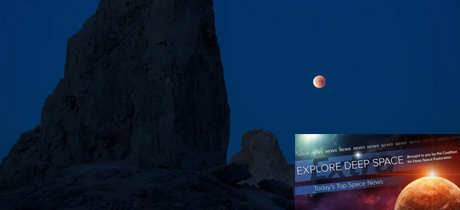In Today’s Deep Space Extra… What will the James Webb Space Telescope’s first images be? NASA leasing act transformed into voting rights legislation.
Space Science
What will the James Webb Space Telescope look at first?
Space.com (1/14): As the James Webb Space Telescope (JWST) begins the lengthy process of aligning its 18 primary mirror segments, a question burns in the astronomical community: What will the huge observatory look at first? “The first images are going to be ugly. It is going to be blurry. We’ll [have] 18 of these little images all over the sky,” Rigby told reporters during a livestreamed press conference on Saturday (January 8) discussing the successful deployment of Webb’s 21.3-foot-wide (6.3 meters) primary mirror that day. Rigby was speaking from NASA’s Goddard Space Flight Center in Maryland, where telescope operations are centered.
Organic molecules in an ancient Mars meteorite formed via geology, not alien life
Science News (1/13) In the mid-1990s, a meteorite of Martian origin and designated Alan Hills ALH84001 due to its discovery in the Antarctic caused a scientific stir in response to claims by NASA scientists that it contained evidence for ancient fossilized microbial life from the Red Planet. Others argued the material was contamination from Earth that entered the 4.09-billion-year-old ALH84001 before it was recovered on Earth in 1984. A new study suggests instead that organic matter within the meteorite probably formed from the chemical interplay of water and minerals mingling under the Martian surface. The latest findings are published in the journal Science.
Scientists think they’ve found a big, weird moon in a far-off star system
NPR.org (1/13): The search is on for moons as well as planets beyond the solar system. A Columbia University-led study has discovered evidence of a possible extrasolar moon that is larger than the Earth and orbiting a Jupiter-like planet, which is orbiting a sun-like star about 5,000 light years away. Some astronomers believe the galaxy’s moon population may include rocky bodies that potentially host conditions for life. But they may be difficult to detect. Still to be verified, the latest discovery was made with data from NASA’s Kepler space telescope and details were published in the journal Nature Astronomy.
Other News
Leasing bill transformed into voting rights legislation
SpaceNews.com (1/14): A bill meant to reauthorize NASA’s ability to lease property at its facilities to companies or other organizations (enter into “enhanced use leases” or EULs) was introduced in October by Rep. Don Beyer (D-VA), chair of the House Science Committee’s space subcommittee. The Senate amended the bill, extending the EUL authorization by only three months instead of 10 years, and passed it by unanimous consent, sending it back to the House. The Democratic leadership of the House then took the Senate-amended bill and stripped out the NASA provisions, replacing it with the text of two voting rights bills. They did so because enhanced use leases legislation, H.R. 5746, had already passed the House and Senate, so the amended version could go directly to the Senate floor without the threat of a filibuster from Senate Republicans, who oppose the voting rights legislation. The move sacrifices the NASA portions of the bill, something that Beyer said he accepted.
DoD space policy nominee highlights complex security challenges facing U.S.
SpaceNews.com (1/13): John Plumb, President Biden’s nominee to serve as the Assistant Secretary of Defense for Space Policy, expressed concerns for a complex global security environment in testimony Thursday before a U.S. Senate Armed Forces confirmation hearing. Plumb specifically expressed concerns over actions by China and Russia.
2021 saw record temperatures and deaths from natural disasters, NASA, NOAA reveal
Space.com (1/14): Earth’s global average surface temperature in 2021 tied with 2018 as the sixth warmest on record, according to independent analyses done by NASA and the National Oceanic and Atmospheric Administration (NOAA). Continuing the planet’s long-term warming trend, global temperatures in 2021 were 1.5 degrees Fahrenheit (0.85 degrees Celsius) above the average for NASA’s baseline period, according to scientists at NASA’s Goddard Institute for Space Studies (GISS) in New York. NASA uses the period from 1951-1980 as a baseline to see how global temperature changes over time.
Virgin Orbit sends 7 satellites to orbit in fourth mid-air launch
Space.com (1/13): Virgin Orbit’s Cosmic Girl conducted its third launch of a Launcher One rocket on Thursday from beneath the wing of a Boeing 747 based at the Mojave Air and Spaceport in California. The payload consisted of seven satellites that were deployed at 6:53 p.m. EST, or a little over two hours after the Cosmic Girl 747 rolled off the runway. NASA and the Department of Defense (DoD) were among the satellite customers.

